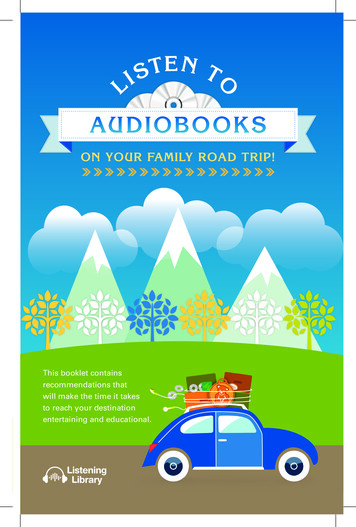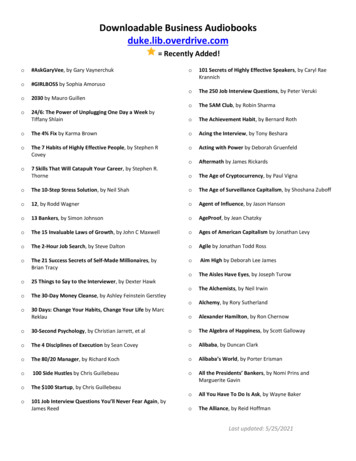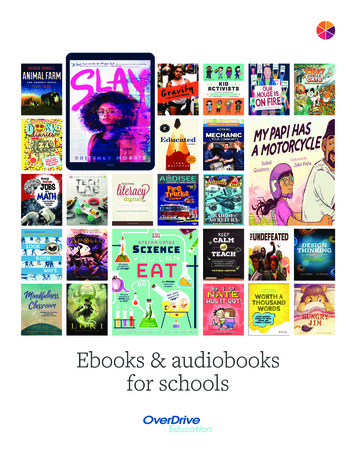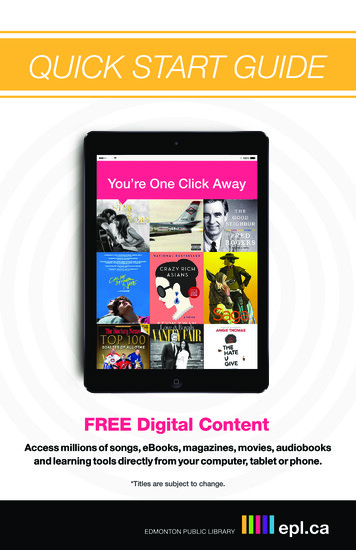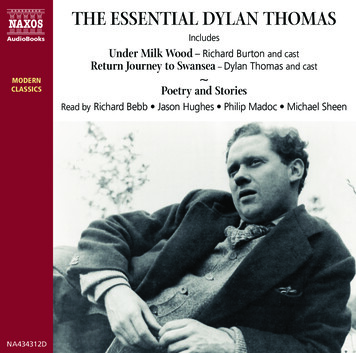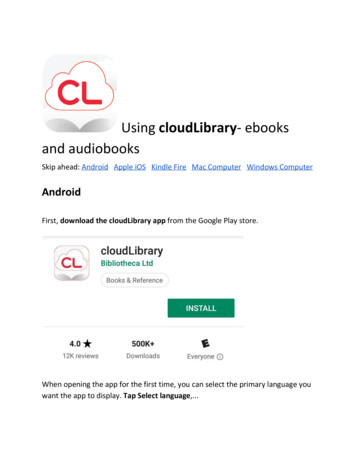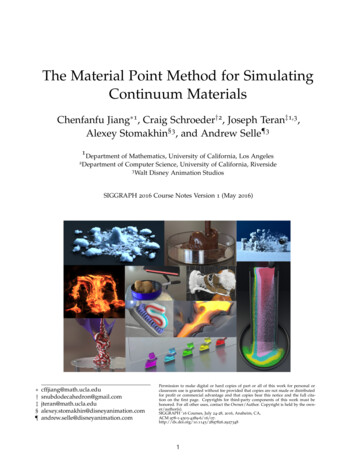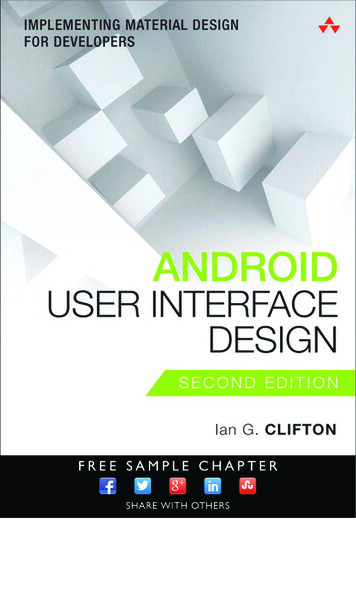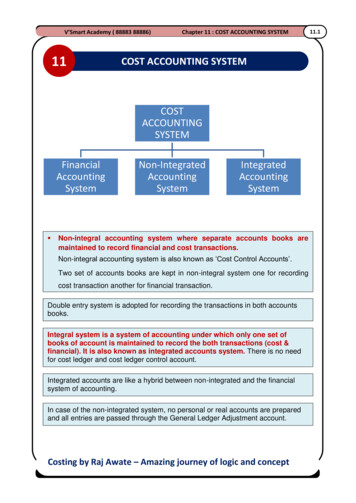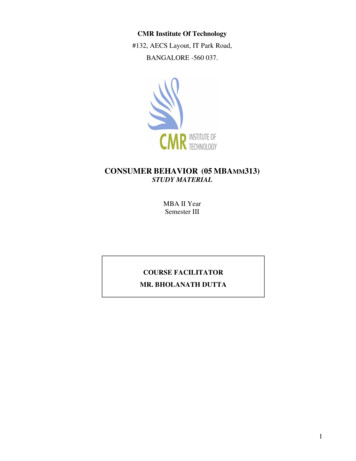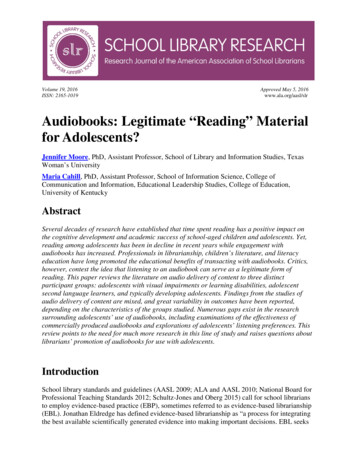
Transcription
Volume 19, 2016ISSN: 2165-1019Approved May 5, 2016www.ala.org/aasl/slrAudiobooks: Legitimate “Reading” Materialfor Adolescents?Jennifer Moore, PhD, Assistant Professor, School of Library and Information Studies, TexasWoman’s UniversityMaria Cahill, PhD, Assistant Professor, School of Information Science, College ofCommunication and Information, Educational Leadership Studies, College of Education,University of KentuckyAbstractSeveral decades of research have established that time spent reading has a positive impact onthe cognitive development and academic success of school-aged children and adolescents. Yet,reading among adolescents has been in decline in recent years while engagement withaudiobooks has increased. Professionals in librarianship, children’s literature, and literacyeducation have long promoted the educational benefits of transacting with audiobooks. Critics,however, contest the idea that listening to an audiobook can serve as a legitimate form ofreading. This paper reviews the literature on audio delivery of content to three distinctparticipant groups: adolescents with visual impairments or learning disabilities, adolescentsecond language learners, and typically developing adolescents. Findings from the studies ofaudio delivery of content are mixed, and great variability in outcomes have been reported,depending on the characteristics of the groups studied. Numerous gaps exist in the researchsurrounding adolescents’ use of audiobooks, including examinations of the effectiveness ofcommercially produced audiobooks and explorations of adolescents’ listening preferences. Thisreview points to the need for much more research in this line of study and raises questions aboutlibrarians’ promotion of audiobooks for use with adolescents.IntroductionSchool library standards and guidelines (AASL 2009; ALA and AASL 2010; National Board forProfessional Teaching Standards 2012; Schultz-Jones and Oberg 2015) call for school librariansto employ evidence-based practice (EBP), sometimes referred to as evidence-based librarianship(EBL). Jonathan Eldredge has defined evidence-based librarianship as “a process for integratingthe best available scientifically generated evidence into making important decisions. EBL seeks
Audiobooks: Legitimate “Reading” Material for Adolescents?Volume 19 ISSN: 2165-1019to combine the use of the best available research evidence with a pragmatic perspectivedeveloped from working experiences in librarianship” (2006, 342).In the school library context, EBP involves knowing stakeholders’ needs, finding existingevidence to address those needs, applying best practices based on evidence, collecting data toevaluate the practice as applied to the local situation, and analyzing, communicating, andplanning based on the local evidence and stakeholders’ needs (Cahill and Richey 2012). Thus,for school librarians to fully implement EBP, they must have access to and be able to interpretexisting research to inform their programming and practices.This paper explores existing evidence relating to literacy development, audiobooks, andadolescents; our goal is to make this evidence readily available to school librarians. We beginwith an overview of the benefits of reading and the rise of audiobook use among adolescents. Wethen summarize claims imparted by professionals across disciplines regarding the benefits ofaudiobook use and position benefits in relation to the Component Model of Reading (Aaron et al.2008). Next, we provide a review of the existing research related to the use of audiobooks withadolescents, and then discuss how the existing research supports or fails to support claims madeabout the benefits of audiobooks for adolescents. Finally, we conclude with implications forpracticing school librarians and for researchers.It is well recognized that engagement in reading is important for the cognitive and academicgrowth of children and adolescents. Since the 1990s researchers have been investigating therelationship between time spent reading and positive outcomes. Students who read for enjoymentand those who spend more time reading in and out of school typically have better readingabilities and general academic success than students who spend little time reading (Anderson,Wilson, and Fielding 1988; Cunningham and Stanovich 1997, 1998; Mol and Jolles 2014;Scarborough 2001; Sullivan and Brown 2013).More recently, literacy scholars have examined adolescents’ literacy behaviors and therelationship between reading in and out of school and social and emotional outcomes. ElizabethBirr Moje and colleagues (2008) explored the reading practices of adolescents in an urbancommunity in the United States and found that those practices affect more than just cognitivedomains. Engagement in literacy activities for and beyond school-based purposes impactsadolescents’ social capital as well as their own identity formation and self-improvementpractices. Gay Ivey and Peter H. Johnston’s investigation of young adults’ engagement withliterature found that the youths’ interactions with the texts transformed their self-identities, senseof agency, and emotional and moral states (2013).Clearly, the cognitive and social benefits of reading point to the efficacy of promoting readingengagement among early adolescents and teens. Yet, many young adults dislike reading, choosenot to read, or engage in other activities that limit the time available to read. One possibleremedy for overcoming these barriers is listening to audiobooks. Despite declining engagementwith reading among young adults (Egmont 2013), adolescents’ use of audiobooks has increased(Audio Publishers Association 2013), as has the availability of young adult audiobook titles(Bowker 2013).Adolescents’ Use of Audiobooks for LeisureYounger Americans tend to use audiobooks more frequently than do older readers (AudioPublishers Association 2010; Zickuhr et al. 2012). While adolescents do purchase audiobooks, asevidenced by a 22 percent increase in sales in the United States (American Booksellers2School Library Research www.ala.org/aasl/slr
Audiobooks: Legitimate “Reading” Material for Adolescents?Volume 19 ISSN: 2165-1019Association 2013), most young adult audiobook consumers prefer to borrow them from thelibrary (Zickuhr et al. 2012). Interestingly, while the number of print materials available inpublic libraries has decreased, the number of audiobooks, in either physical or downloadableformat, has nearly doubled in recent years (Chute and Kroe 2007; Grimes et al. 2013).While it is clear that adolescents do indeed use audiobooks, no studies have explored exactlyhow adolescents do so nor what their listening preferences are. While adult audiobook listenerstend to be avid readers, it is unclear whether the same holds true for adolescents (Aron 1992).Library and Educational Professionals’ Claims about theBenefits of AudiobooksListening skills’ contributions to literacy have long been recognized by education scholars(Pearson and Fielding 1982), and the necessity of listening proficiency among adolescents andyoung adults has regained prominence in schools in the United States because of the recentimplementation of the Common Core State Standards (2010). The professional literature inliteracy education, librarianship, and children’s literature claims numerous educationaladvantages of children’s and young adults’ transacting (Rosenblatt 2005) 1 with audiobooks(Neuman 2005; Serafini 2006). In textbook packages for teachers, publishers often include audioversions of their print texts or portions of their print texts. Numerous entities, includingprofessional library associations, commercial publishing associations, review sources, and eventhe Recording Academy (issuer of the Grammy Awards), bestow awards and recognitions foroutstanding audiobooks and narrators. NoveList, a readers’ advisory tool, recently addedaudiobook recommendations and listen-alikes to its services (EBSCO 2014). Even respondentsto the Audio Publishers Association’s 2010 survey on audiobook usage have cited multiplebenefits of audiobooks for children and young adults. These benefits include encouragingreading, introducing topics and titles unfamiliar to the readers, and developing a love of reading.Reading with the Ears versus Reading with the EyesListening to books is a valued activity that is encouraged for young children. An often-quotedstatement by the United States National Academy of Education’s Commission on Reading atteststo this emphasis on listening to text: “The single most important activity for building theknowledge required for eventual success in reading is reading aloud to children” (Anderson et al.1985, 23). However, scholars and educators argue about the usefulness of the activity and thevalue of this educational practice for older children, adolescents, and adults (Johnson 2003). Infact, Elfrieda H. Hiebert has asserted, “Children can learn a great deal about the language andcontent of texts through listening to experienced readers read texts aloud; however, unlesschildren’s eyes are making contact with print and translating print into meaning, they can’t bedescribed as reading” (2009, 1).Thus, despite the claims among professionals that audiobooks are educationally beneficial forchildren and young adults, critics challenge the idea that listening to audiobooks constitutes alegitimate form of reading (Cooper 1993). Though similar to reading, transacting with an1For additional information about Transactional Theory, please consult “Writing and Reading: The TransactionalTheory” (Rosenblatt 1988).3School Library Research www.ala.org/aasl/slr
Audiobooks: Legitimate “Reading” Material for Adolescents?Volume 19 ISSN: 2165-1019audiobook differs from reading a print-based book. Naturally, print book reading primarilyinvolves the eyes while audiobook use involves the ears, but the similarities and differences aremuch more nuanced than simple consideration of the organs involved. Frank Serafini contendedthat listening to an audiobook “deepens readers’ interpretations and develops their ability tocomprehend and analyze literature” (2006, 91). He further asserted that audiobook listening canintroduce readers to new literature and different genres, provide exposure to materials beyondtheir independent reading abilities, develop vocabulary, provide models of fluent reading, andpromote struggling readers’ literacy development (if they listen while reading).Pamela Varley (2002), mentioning but not citing a Carnegie Mellon brain study comparingreading and listening, pointed to the physiological variances that occur in the brain when readingcompared to those when listening: different areas work harder in the brain depending on themode of the activity, but the language-comprehension system works similarly during both. GeneWolfson further contended, “Audiobooks can model reading, teach critical listening, build onprior knowledge, improve vocabulary, encourage oral language usage, and increasecomprehension. Essentially, reading audiobooks supports the development of all four languagesystems: phonological, semantic, syntactic, and pragmatic” (2008, 106). Nancy Frey andDouglas Fisher (2006) also pointed to the utility of using audiobooks with adolescents as ameans to strengthen the link between oral and written literacies.Reading has often been characterized according to a Simple View (Gogh and Tunmer 1986), inwhich comprehension is thought to be a product of decoding ability and linguisticcomprehension. Under this model, it would follow that audiobooks would facilitatecomprehension for students who struggle to decode and that rich listening experiences wouldcontribute to linguistic comprehension skills that would, in turn, support further readingcomprehension skills.However, most classroom teachers and school librarians recognize the nuanced nature of readingcomprehension and the influences of many other elements that support or hinder readingproficiency, and research supports this perspective. Both motivation (Guthrie et al. 2007) andexecutive skills, specifically cognitive flexibility and working memory, that are requisite for anycomplex task (Cartwright, Marshall, and Wray 2016) also impact reading comprehension.Similarly, the learning context and environment also factor into successful reading performance(Berninger et al. 2004).The Component Model of Reading (Aaron et al. 2008) posits that multiple components,organized under the three domains of cognitive, psychological, and ecological components,influence reading proficiency, and that any deficit in any component can interfere withsuccessful reading. Cognitive components include decoding, linguistic comprehension, andexecutive-function skills. Psychological components include factors such as motivation andinterest, gender, learning styles, and task purpose. Finally, ecological components include cultureand other factors of the home environment and classroom environment, dialect, and secondlanguage learner status.Audiobook Contributions to Adolescent Listeners’ LiteracyDevelopment and Content KnowledgeResearch exploring audiobooks is necessary for determining if or how engagement withaudiobooks really does affect adolescent users in meaningful ways. While some studies havebeen conducted with commercially produced audiobooks, much of the research in this area draws4School Library Research www.ala.org/aasl/slr
Audiobooks: Legitimate “Reading” Material for Adolescents?Volume 19 ISSN: 2165-1019on more-general studies of audio delivery of content: written texts that are read aloud, teacherand/or researcher-produced recordings of read alouds, and commercially produced audiorecordings of texts that fall beyond the realm of a traditional audiobook production (e.g., anaudio recording of a textbook passage).Naturally, for students with sight limitations, audiobooks facilitate independent learning. AydinZiya Ozgur and Huseyin Selcuk Kiray (2007) randomly select
Audiobooks: Legitimate “Reading” Material for Adolescents? Jennifer Moore, PhD, Assistant Professor, School of Library and Information Studies, Texas Woman’s University Maria Cahill, PhD, Assistant Professor, School of Information Science, College of Communication and Information, Educational Leadership Studies, College of Education, University of Kentucky . Abstract . Several decades of .
